Valencia is basically an open-air gallery decorated with many amazing murals – you just need to walk around with your eyes open and your camera ready to spot the city’s best street art.
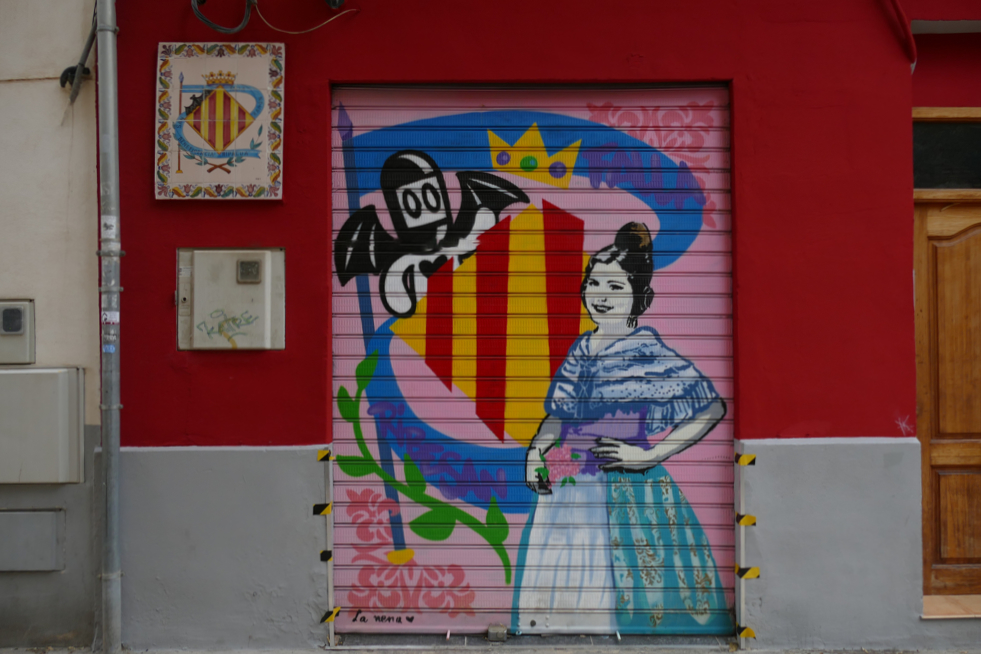
So, don’t be shy to walk down small back alleys, turn into backyards, and follow the slightest signs of urban art.
There aren’t just a couple of keywords that can define street art in all its shapes and forms. As a matter of fact, the art of sketching and painting on walls goes way back to the cavemen, to the era of the Pyramids in Giza, as well as the Roman Empire.
Then, the contemporary graffiti movement started in the 1960s as a claim of urban territory by gangs as well as a response to the political and social injustice going on around the world. Graffiti developed from the so-called tagging, hence writing names’n’slogans in a more or less artsy way.
On the other hand, larger than life wall-paintings have their roots rather in murals from Latin America. The most famous muralist was probably Frida Kahlo’s husband Diego Rivera. Albeit, he rather depicted and honored the Indigenous heritage and culture than facing social problems and protests.
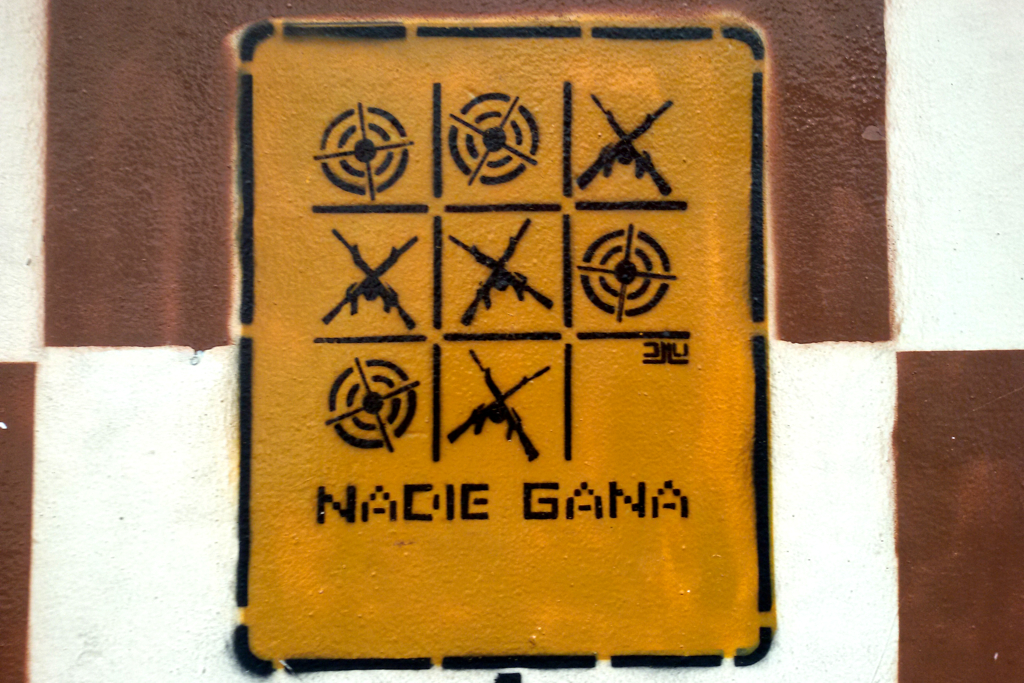
Yet, you can often spot a rebellious undertone in urban art. Maybe it’s because you’ll find it frequently on abandoned buildings, objects of capitalist speculation in urban areas. While graffiti and murals in run-down neighborhoods depict social problems, in other areas, some pointless smearing is simply vandalism.
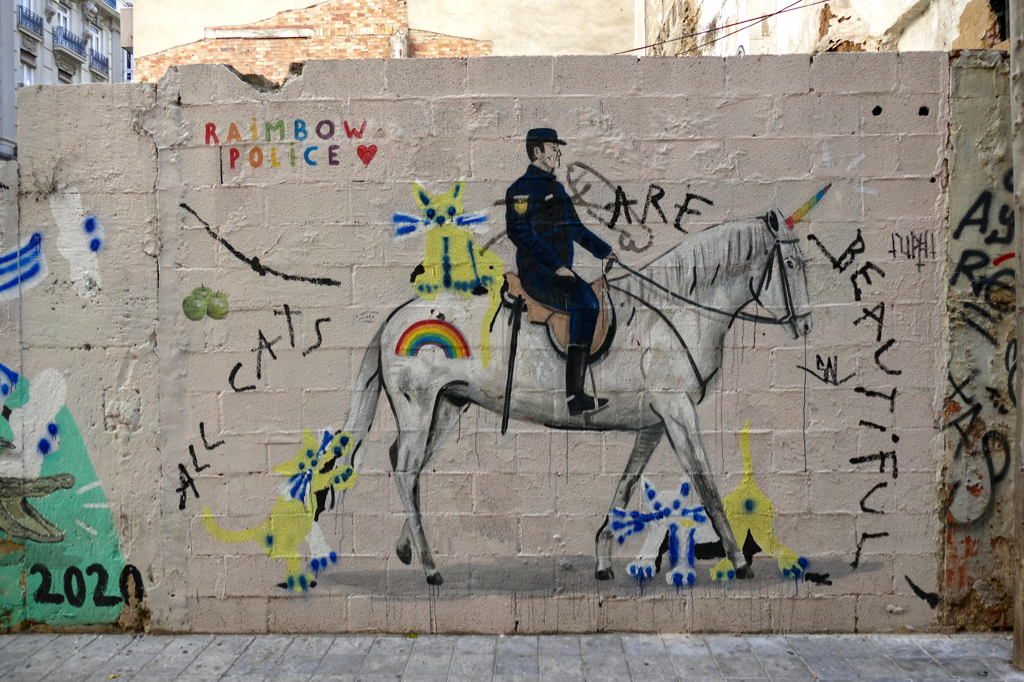
This difference is sometimes a very thin line and leaves much room for interpretation – as well as heated discussions and legal consequences.
Uncensored Canvases
However, let’s be real here – over the past decades, street art is not only going but actually racing towards the mainstream since hip galleries and posh art lovers are adding works by famous street artists to their collections. The first Street Art Museum opened in Berlin back in 2017, after all. Private house owners, communities, as well as local governments commission artists to decorate designated walls’n’structures. Obviously, street art is also included in tourist tours around the globe.

Now, while this is certainly not the spirit of rough’n’revolutionary urban art, it is a development that actually helped many artists by lifting illegal spraying and painting to an accepted form of culture. Here, too, it is a pretty thin line – but maybe it’s exactly this controversy that keeps urban art interesting and inspiring and – alive.
Valencia
In many places like for instance Singapore, George Town, Rio de Janeiro, and most recently Málaga, I’ve seen beautiful murals. Many of those were commissioned either by the city or by private sponsors. That without any doubt is wonderful for the urban artists. However, you do see the difference. Most of the time, those paintings are simply not as rough’n’raw as street art on crumbling walls and abandoned buildings.
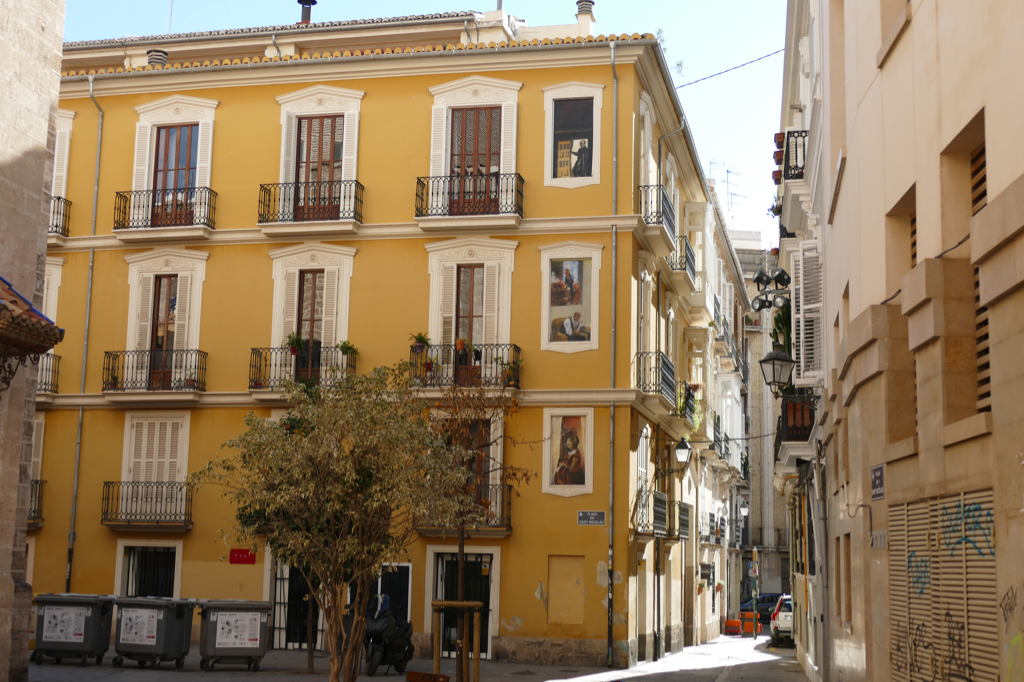
Apartments in this building are rented out by a posh real estate agency, by the way.
Valencia has a perfect mix of both. For instance, the Institut Valencià d’Art Modern, short IVAM, has commissioned urban artist Escif to decorate their rear wall, and street painter Cabiscol has decorated the headquarters of Valencia’s Associations of Senior Citizens CIMA. Also, many stores hire artists to paint their shutters. Nevertheless, there is a fantastic number of angry and wild pieces pointing out political problems and social injustice.
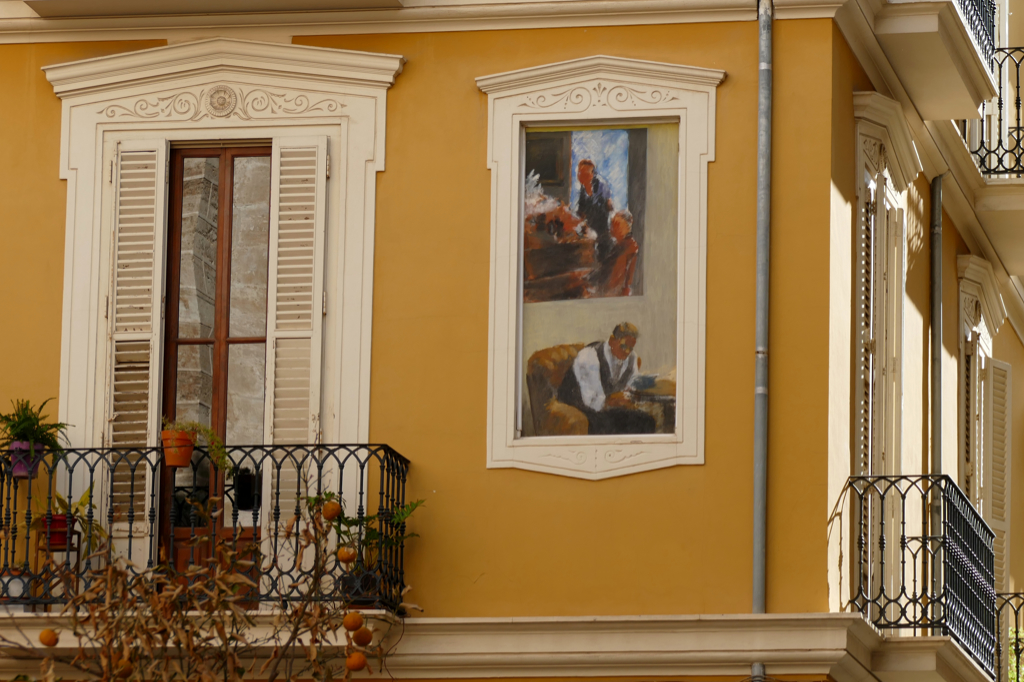
While there are many official street art festivals in the city with contributions from some of the best street artists in the world, large parts of Valencia are still blatant and rebellious open-air galleries.
Who Is Who
Experts will probably notice that in my list of artists below, I’ve skipped some of Valencia’s famous urban artists such as MRBT62, Hyuro, and Bowy. Well, to be honest, since you see their works in so many articles on street art in Valencia, I wanted to mix things up a little. Obviously, I simply couldn’t ignore superstars like Blu and the omnipresent David De Limon. However, I wanted to give some of the less famous yet equally talented folks a chance.
Street art changes, appears, and vanishes constantly, and urban art in Valencia is no exception to this rule. In the map below, you’ll find the exact or at least approximate location of the works I’m introducing in this post. Nevertheless, it’s possible that as you get there, they’ll be gone. Or maybe replaced by another wonderful work. So take this overview of artists as an inspiration to enjoy your own search’n’research for the best street art in Valencia.
Shutters
Painted shutters are a very Spanish thing. I’ve seen them in every city where I was looking for urban art. However, the density of truly powerful paintings was particularly high in Valencia.
Unfortunately, it wasn’t possible to identify those talented artists – or find out more about them.
Therefore, I’m inviting you to just enjoy this gallery of my favorite shutter paintings without giving you much information.
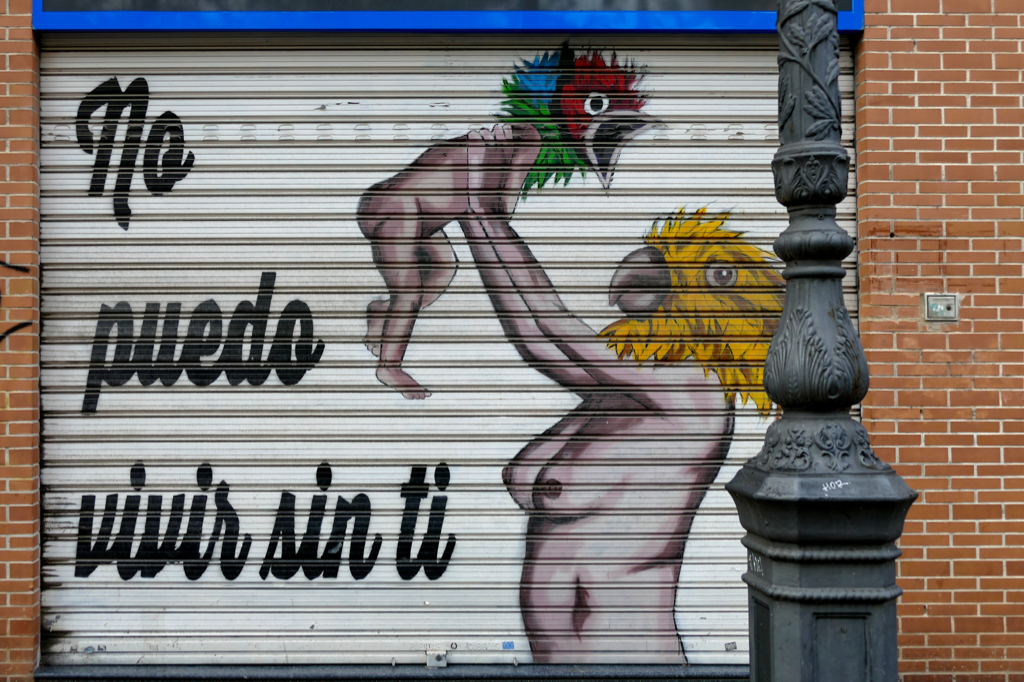
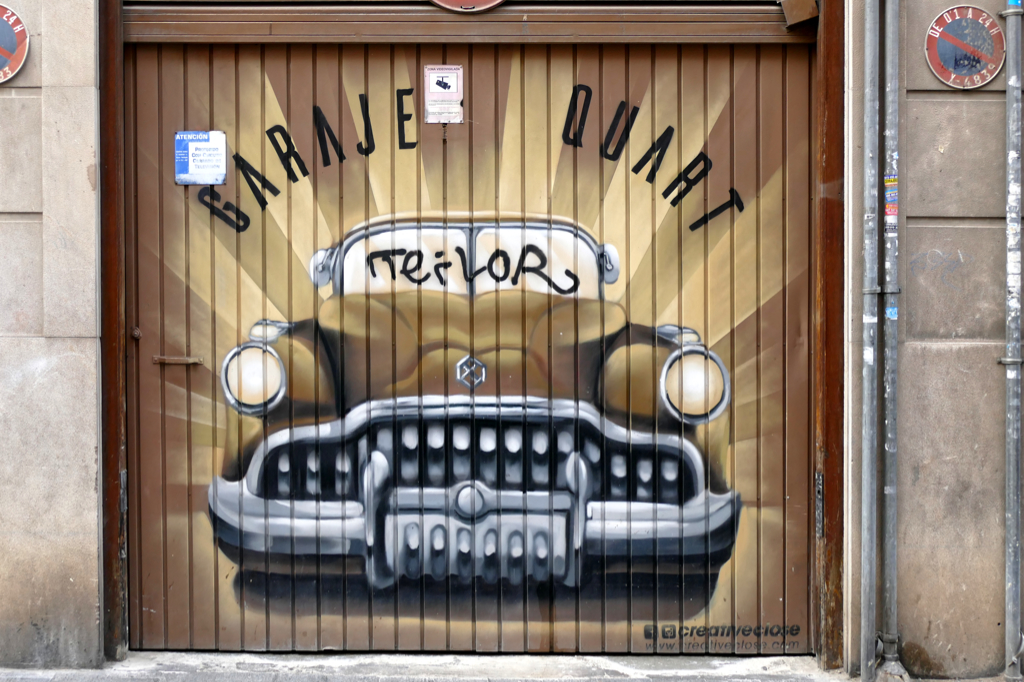
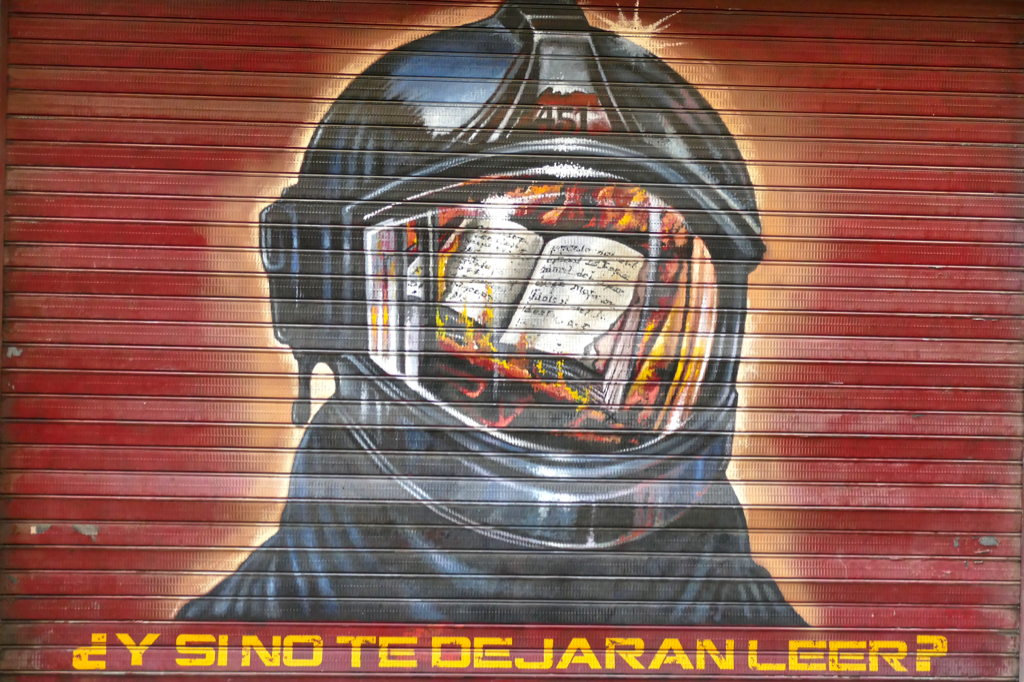
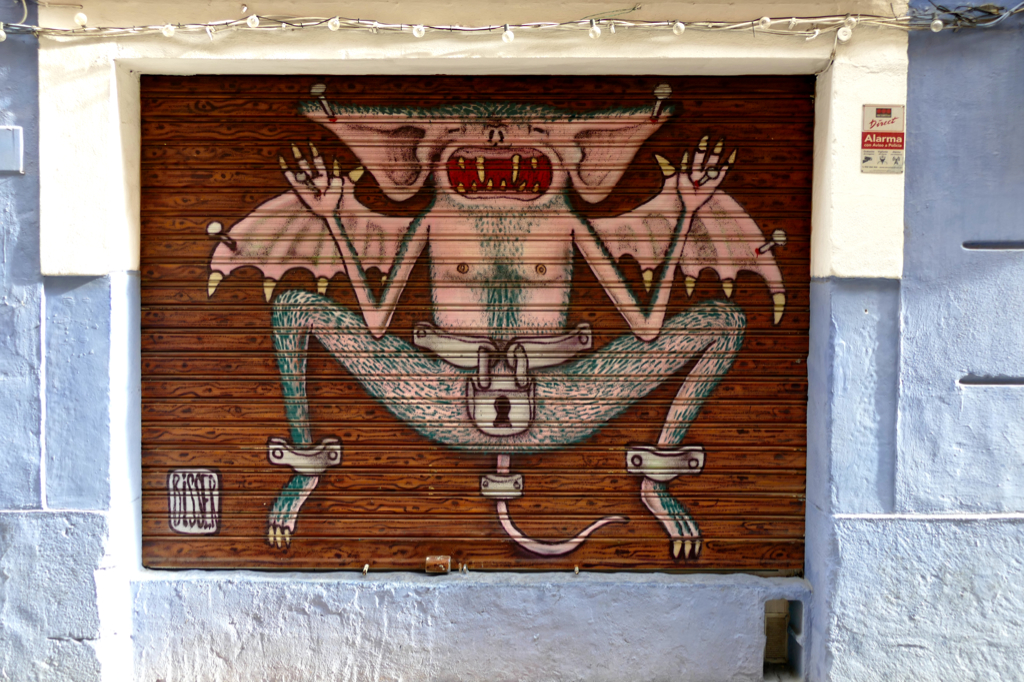
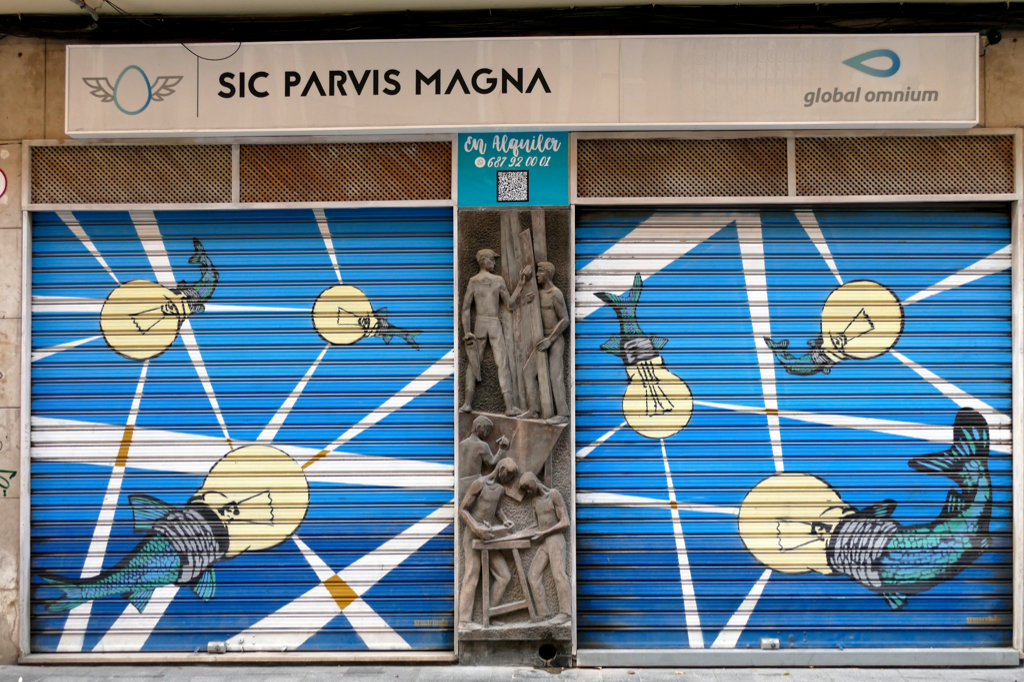
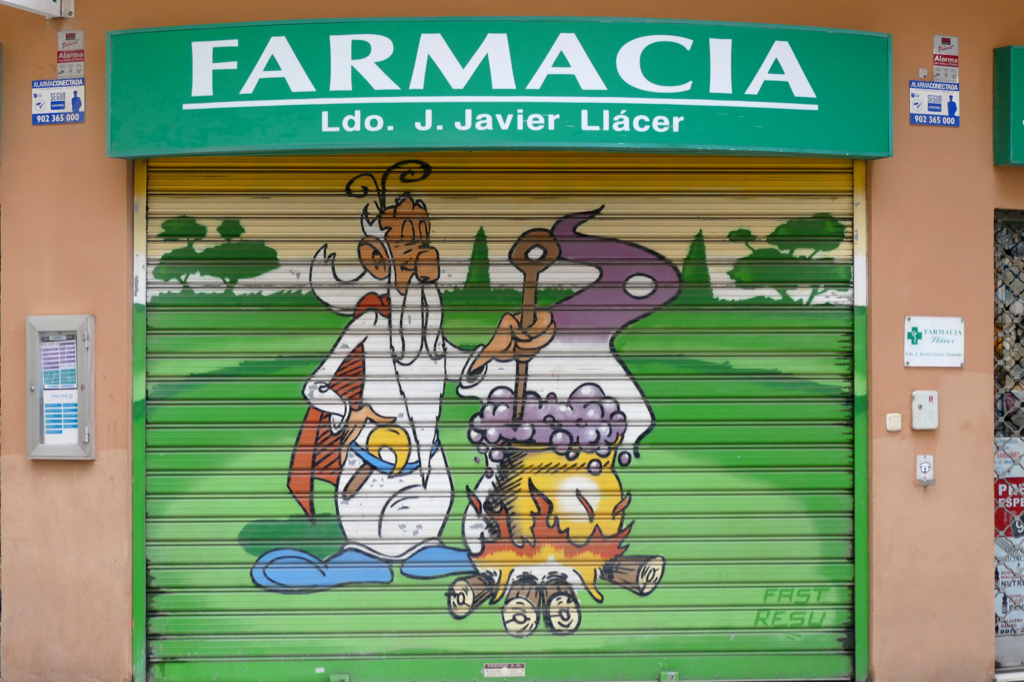
Artists
After the introductory window shopping, let’s dig deeper into Valencia’s art scenes and take some of the most important representatives into focus.
Blu
Blu was born in Senigallia in the Marche region on Italy’s east coast in the early 1980s. Today, he’s living in Bologna.
Since he’s carefully hiding behind his pseudonym, it’s basically impossible to find out more about him as a person. Experts describe this graffiti, street art, and video artist as one of the internationally most noteworthy and essential street artists of muralism.
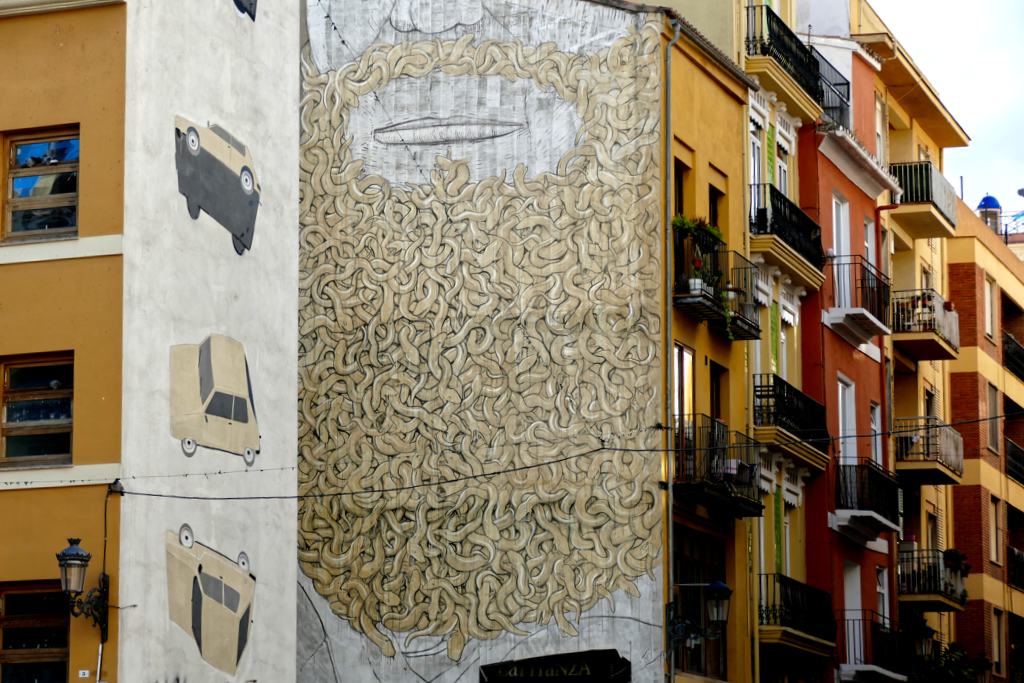
Since the mid-1990s, Blu’s works decorate walls in several European countries, in the Americas, as well as in the West Bank. In 2006, Lorenzo Fonda shot the documentary MEGUNICA about Blu’s work and travel through Mexico, Guatemala, Nicaragua, Costa Rica, and Argentina.
The Guardian voted his collaboration with Os Gêmeos, the famous street art twins from São Paulo in southern Brazil, as one of the top ten street artworks in 2010.
Fun fact: His iconic Moses with a snake beard is Valencia’s most posted wall on Instagram.
Carlos Andújar Domingo
Carlos Andújar Domingo aka Cabiscol Poietikos was born in Valencia.
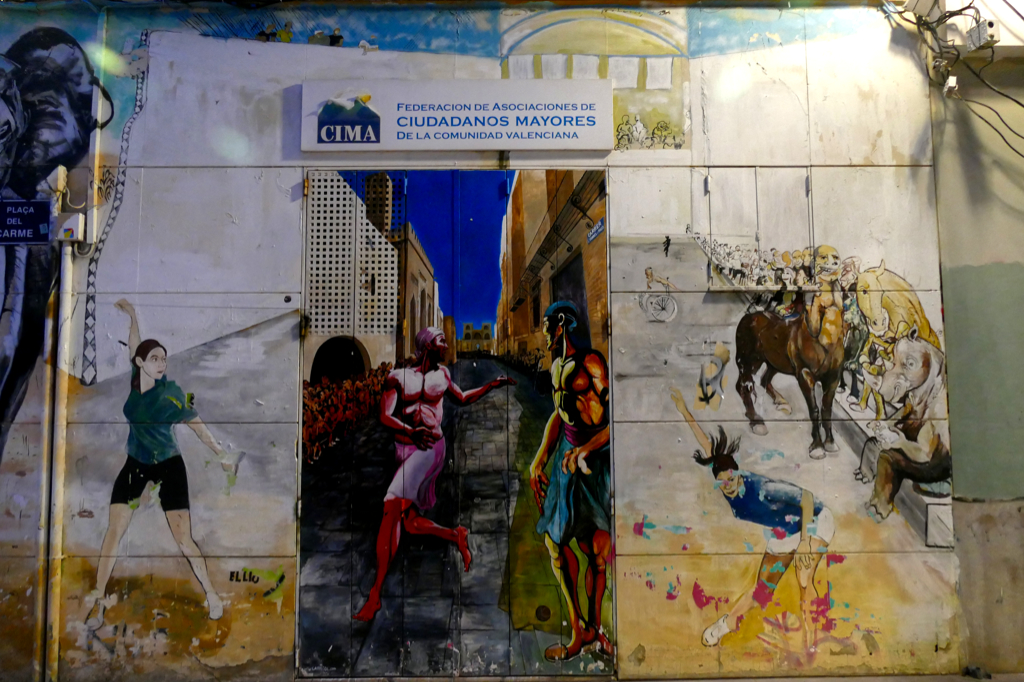
He combines great artistic skills with political and social engagement. As an artist, Cabiscol is constantly crossing borders between abstraction and realism. He’s combining his portraits with anthropomorphic as well as zoomorphic creatures against dream-like and cosmological backgrounds.

Therefore, Carlos Andújar Domingo was commissioned to paint the headquarters of Valencia’s Associations of Senior Citizens CIMA.
David de Limón
David de Limón studied design and photography in Valencia and began to decorate the walls of his hometown in 1998. Although he allegedly chooses the spots for his graffiti very carefully, I’d argue that you can spot his iconic ninjas practically everywhere in the city center.
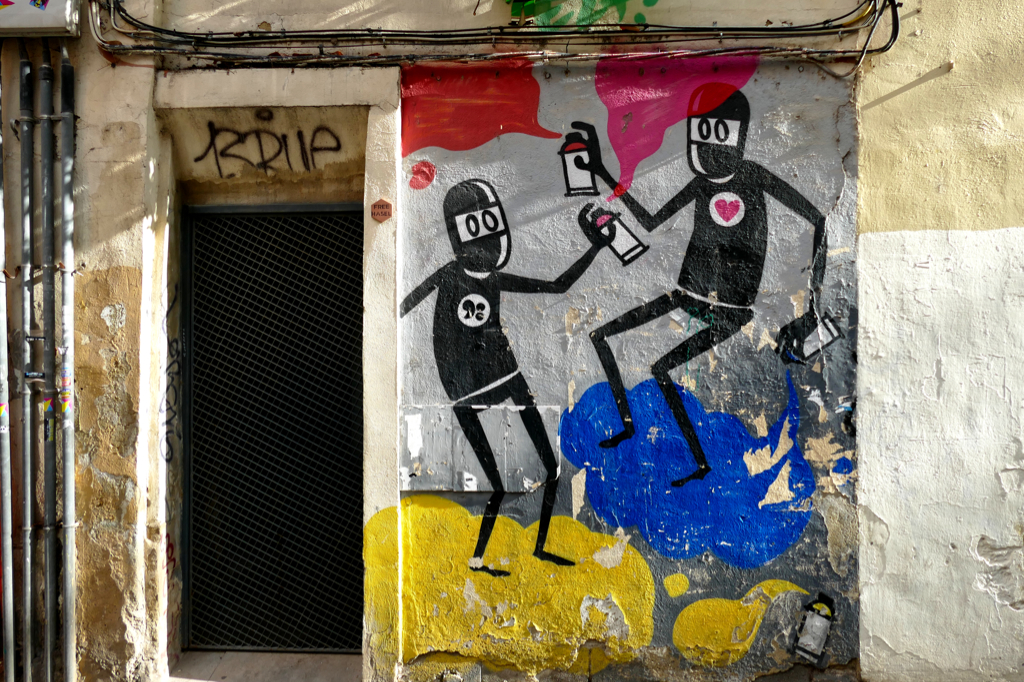
The artist, who was born in the now more or less gentrified neighborhood of El Carme, hides his little ninja’s identity behind masks. Obviously, this is a reference to those graffiti and street artists that still have to decorate walls illegally. I assume for him, that’s not an issue anymore as his iconic characters are internationally famous.
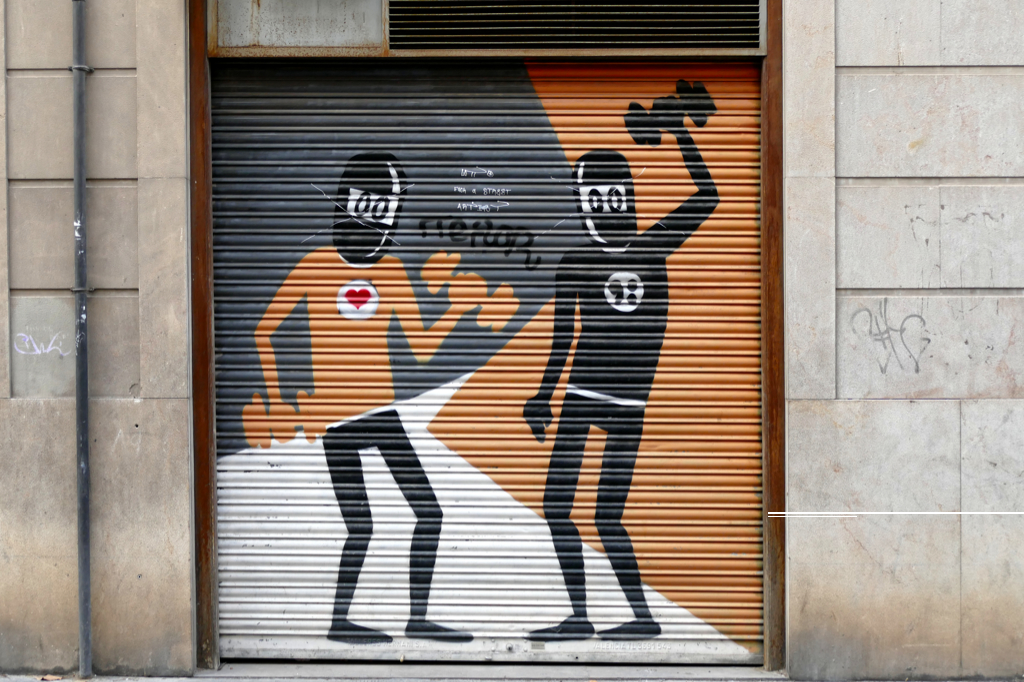
Watch out for two things: Firstly, check the circle on their chest since it reflects their mood. And then, look for them also in other artist’s work – like for instance in this post’s first picture.
Since 2010, David de Limón has exhibited in many galleries in Spain and is present in festivals dedicated to urban art.
Disneylexya
That Disneylexya is a Chilean street artist becomes obvious once you look closer at the vivid colors and indigenous inspired designs. Since he grew up in Southern California, he was exposed to a lot of Mexican art. Today, however, he’s based in Valencia.
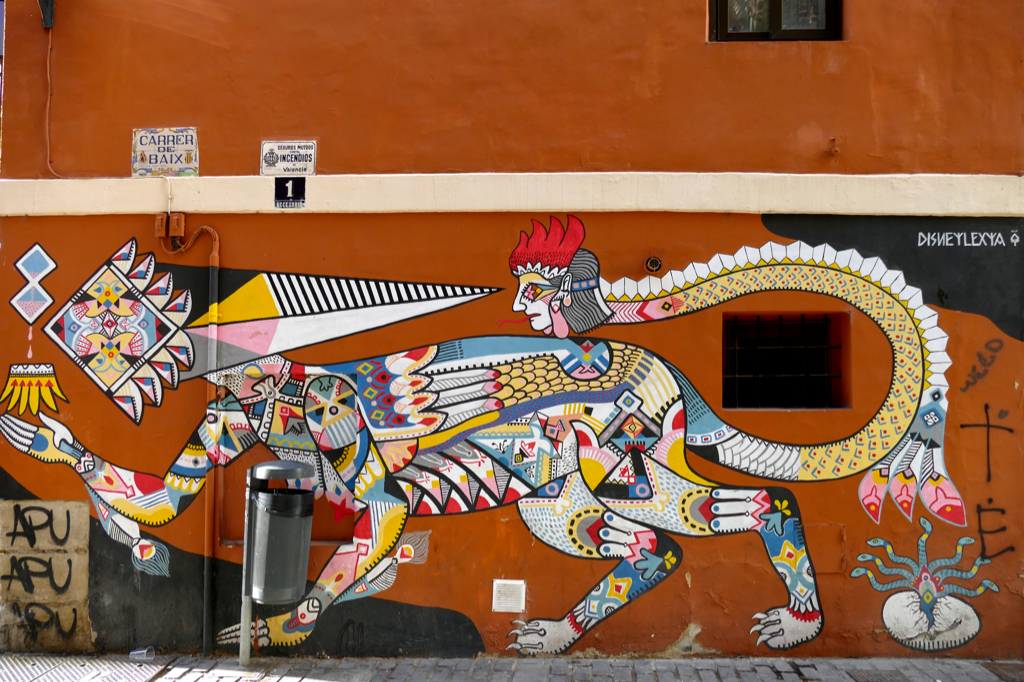
He combines native Latin American designs with medieval European bestiaries and alchemical aesthetics. Consequently, he has chosen the name Disneylexya to underline his combination and interpretation of ancient mythology and his personal symbology.
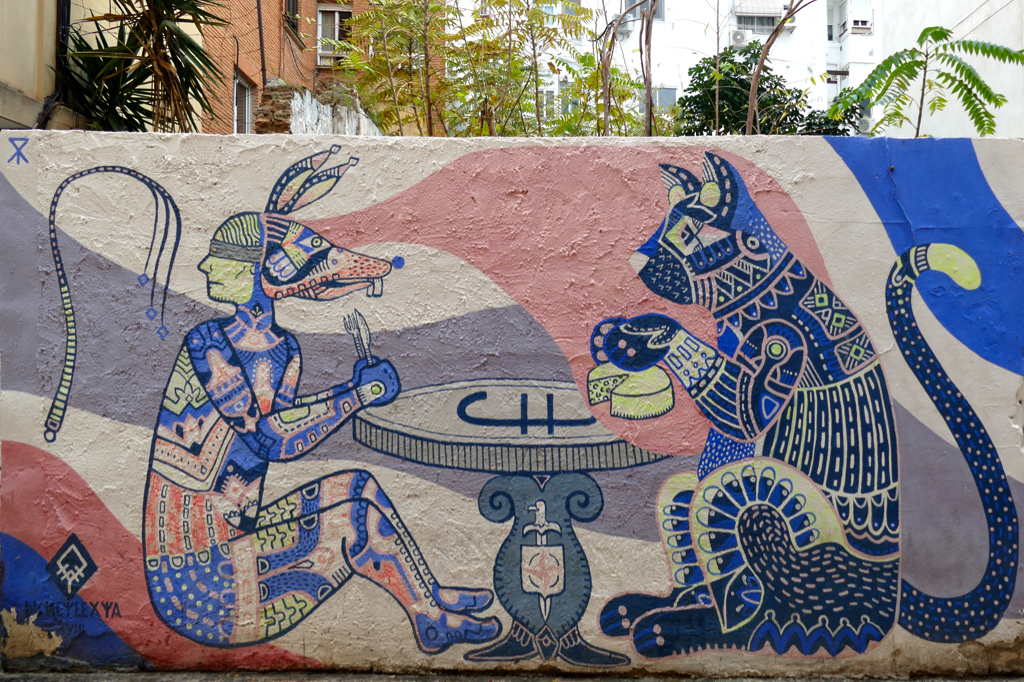
Apart from embellishing the streets of his adoptive home, Disneylexya designs T-shirts and beer bottles, he illustrates magazines and paints for the car manufacturer Audi. Also, he collaborated with David De Limón and La Nena Wapa Wapa on an art project for the Spanish beer brand Mahou.
Escif
This artist that goes by the name of Escif created arguably the largest mural in Valencia. On 2000 square meters, he decorated the rear wall of the Institut Valencià d’Art Modern, short IVAM.
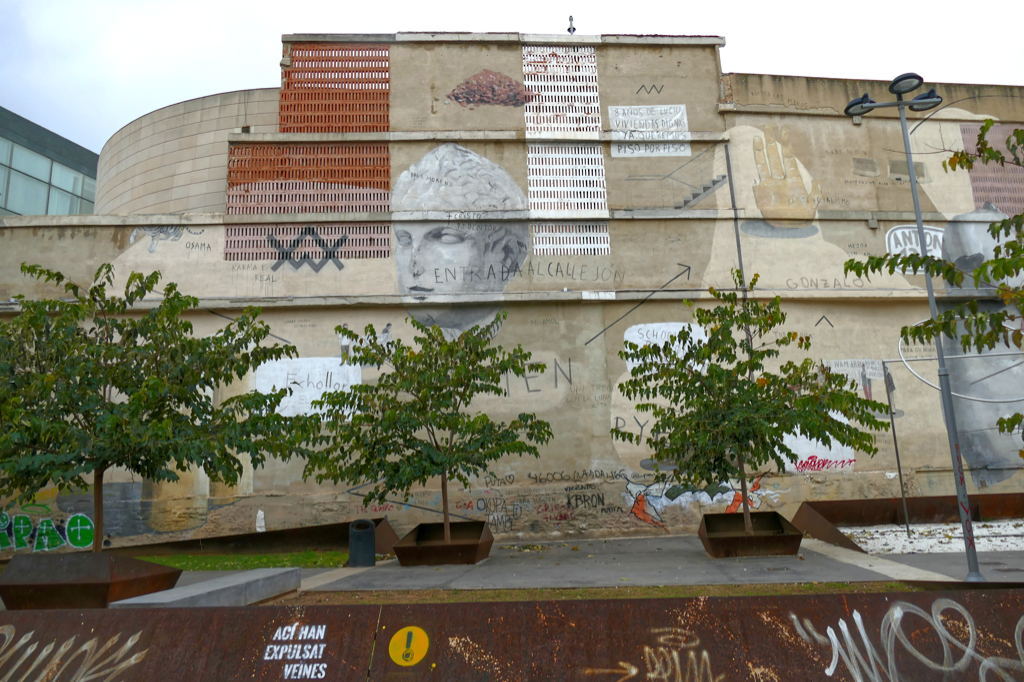
Escif got inspired by the history of the neighborhood and his relationship with the site in the Carmen neighborhood.

The mural deals with the past, present, and future of the museum. If you look closer, you’ll detect some gibes referring to the ever-present gentrification. I guess the writing that translates to “if you are reading this it is too late” does not leave much room for interpretation.
Azucena González
Azucena González was born in Valencia in 1981. She is an allrounder, working as a painter, illustrator, sculptor, artistic director, singer, and performer.
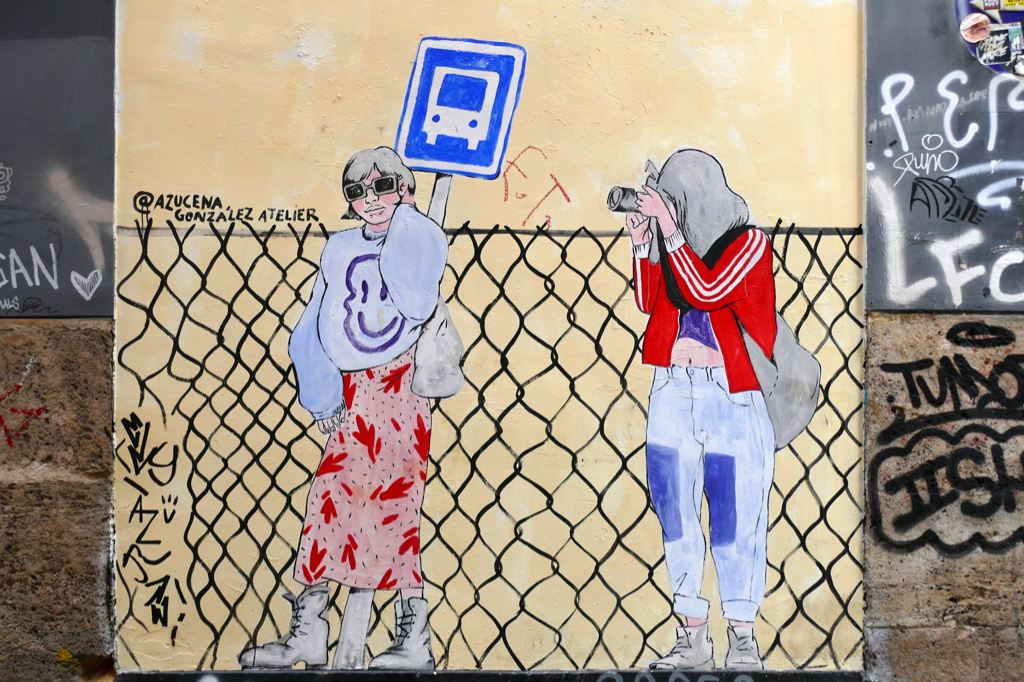
Since Azucena’s father was an artist, she was fed art basically from the day she was born. Since drawing and creating was the family’s second nature, she got a degree in Fine Arts and a Master’s in Artistic Production from the Polytechnic University of Valencia. González’s work reflects her experience and desire and has been presented in various exhibitions.
Julieta XLF
Julia Silla aka Julieta XLF was born in Valencia in 1982. She has a degree in Fine Arts and a Master’s degree in illustration.
Since 2004, Julieta painted in public spaces around Valencia, Alicante, and Madrid, but she made also all the way to Lima and Buenos Aires, to mention just a few of the cities where you can run into her work – only metaphorically, I hope.
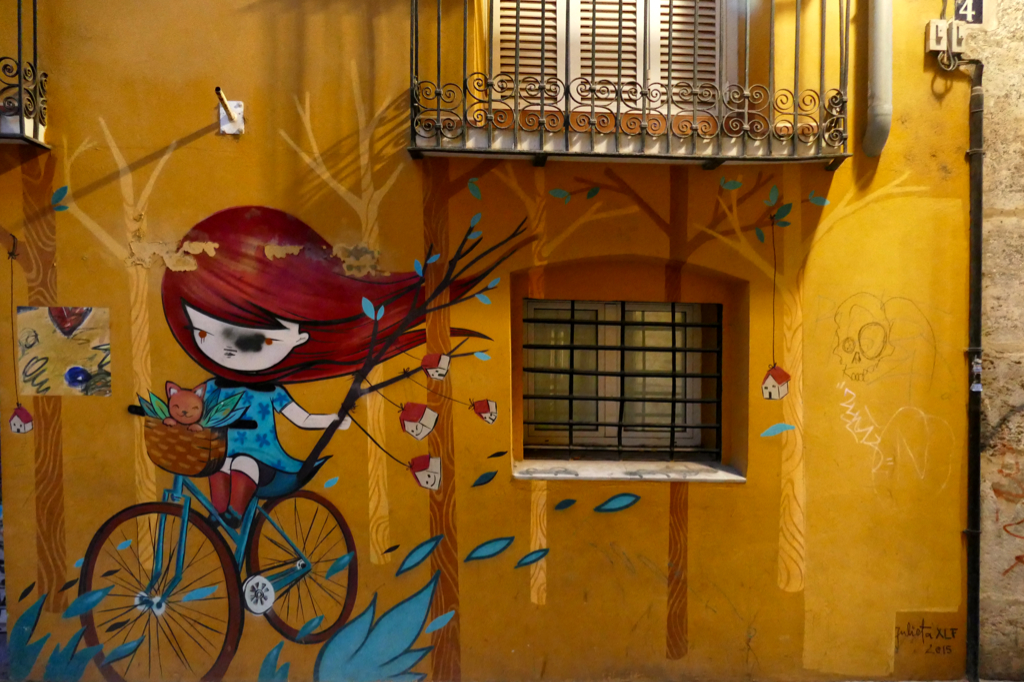
She also participates in contests, exhibitions, and open calls for urban art in Spain and beyond.
Despite the international recognition of her artistic skills, there is no deeper meaning in her pieces. Unlike many other urban artists that depict satire or politics, Julieta’s murals are happy and bright and meant to be simply enjoyed. Well, I must admit that I find such a tamed and innocent approach stereotypically feminine – which I find kinda problematic.

She’s part of the XLF crew with Deih and paints collaborations with him often.
La Nena
Now, Julieta’s female fellow street artist Raquel Ruiz is a whole different story. She was born in Valencia and goes by the pseudonym La Nena as well as La Nena Wapa Wapa.
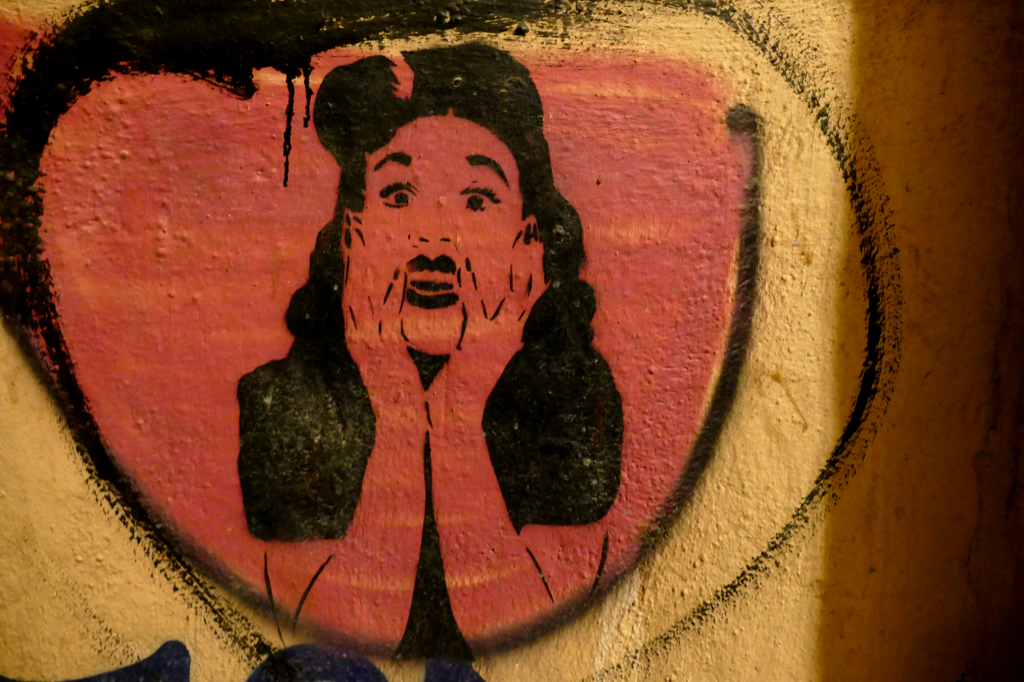
Born in 1977, she graduated in Fine Arts from the Polytechnic University of Valencia in 2004 while she has begun to paint already back in 2002.
Her topics are often related to the concept of femininity. However, she leaves enough room for individual interpretation. In 2009, she founded a female urban art group by the name Fatal Maris which sadly didn’t last very long.
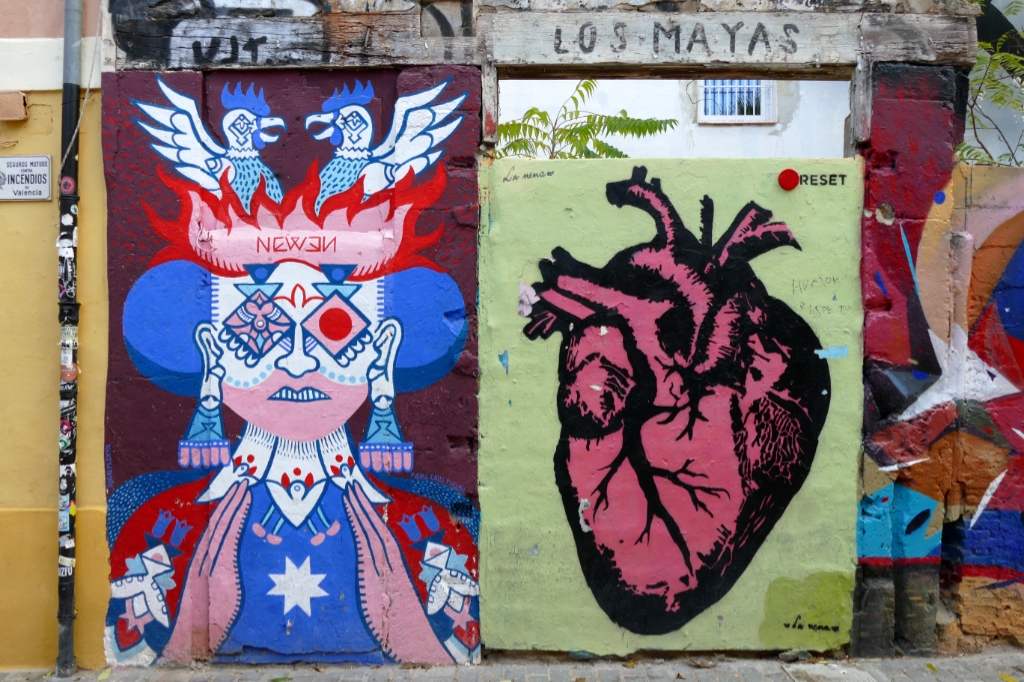
Her style of painting deems charmingly retro with core motifs in black and white.
La Nena is one of the most popular female street artists. Her stenciled portrait of a startled woman is an icon and can be found on various buildings throughout the city. Supposedly, it’s an auto-portrait.
Luis Lonjedo
One of Valencia’s most iconic and therefore most photographed murals is Prohibido de no Besarse – it’s forbidden not to kiss. In this painting, Luis Lonjedo adopts an image that photographer Alfonso Calza shot in London in 2012.
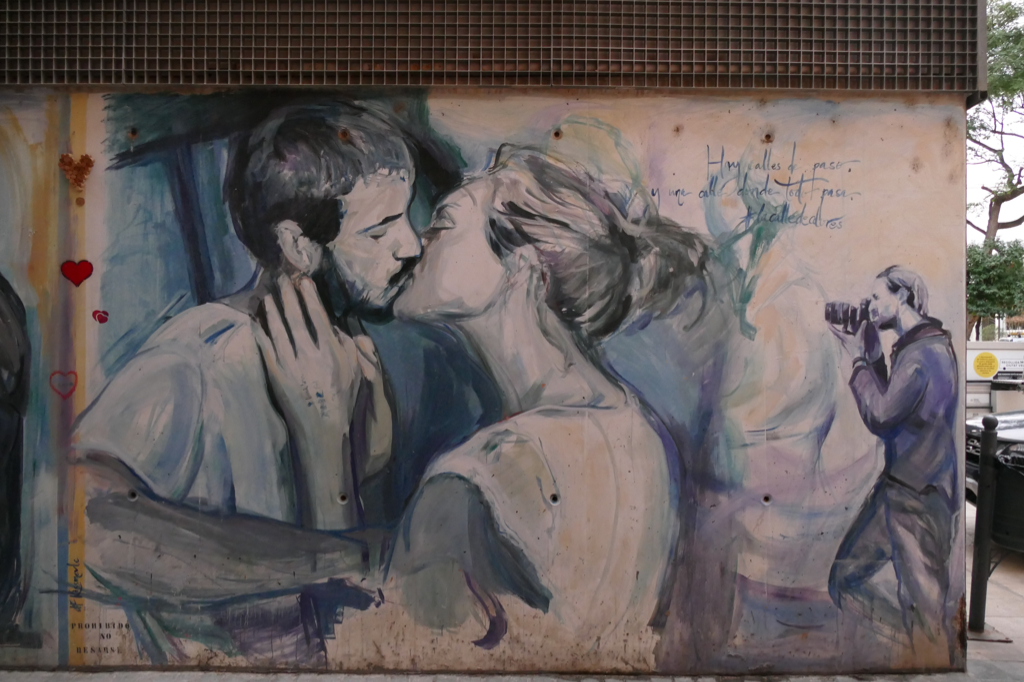
Since we are living in a global Instagramlandia, today, you’ll find lots of couples who recreate the depicted intimate moment in front of the mural.
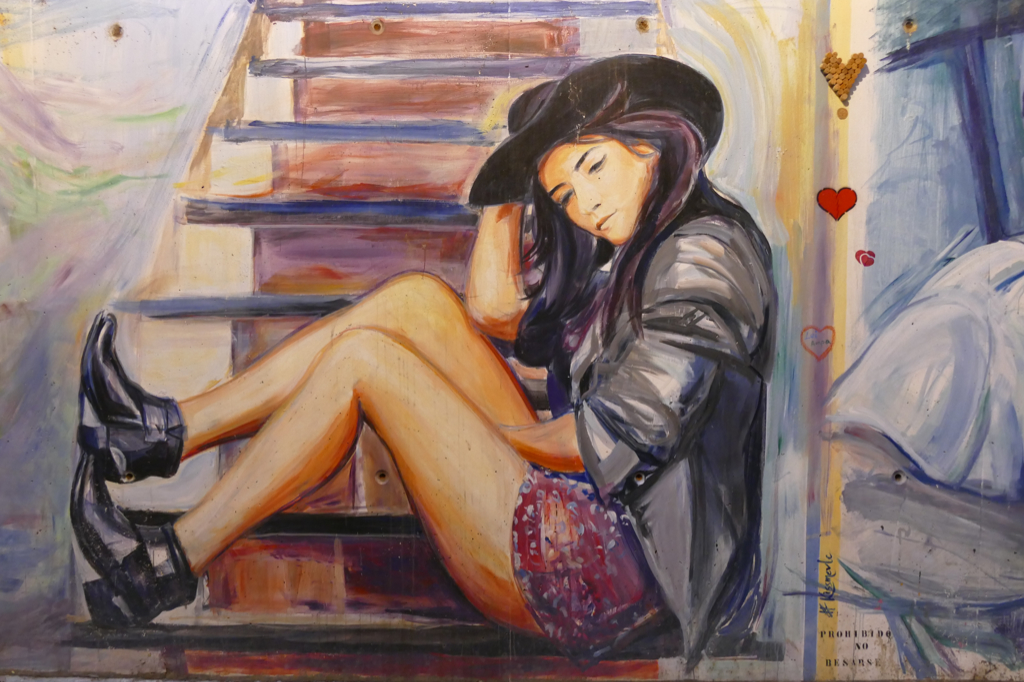
And while Lonjedo’s painting inspires hundreds of random couples to pose in front of his work, ironically, the real couple was never found. Whether they broke up or their love is still in full bloom, it will forever live on in Lonjedo’s painting – and countless Instagram accounts using the hashtag #kissmevlc.
Calle de los Colores
Carrer de Moret Street used to be a dingy’n’dodgy street in the El Carme neighborhood. One day, local photographer and artist Alfonso Calza had enough – he wanted to see colors and happiness when stepping out of his studio. A word, a blow, he brought together some of the most talented street artists. With their beautiful paintings, Deih, Zíngaro, Luis Lonjedo, and others transformed the street into the Calle de los Colores, the street of colors. Obviously, the mural Prohibido de no Besarse became this project’s icon – as described above.
Sig. Luigi
Sig. Luigi is the other Italian artist on my list who created at least one iconic piece – namely a portrait of Tupak Shakur.
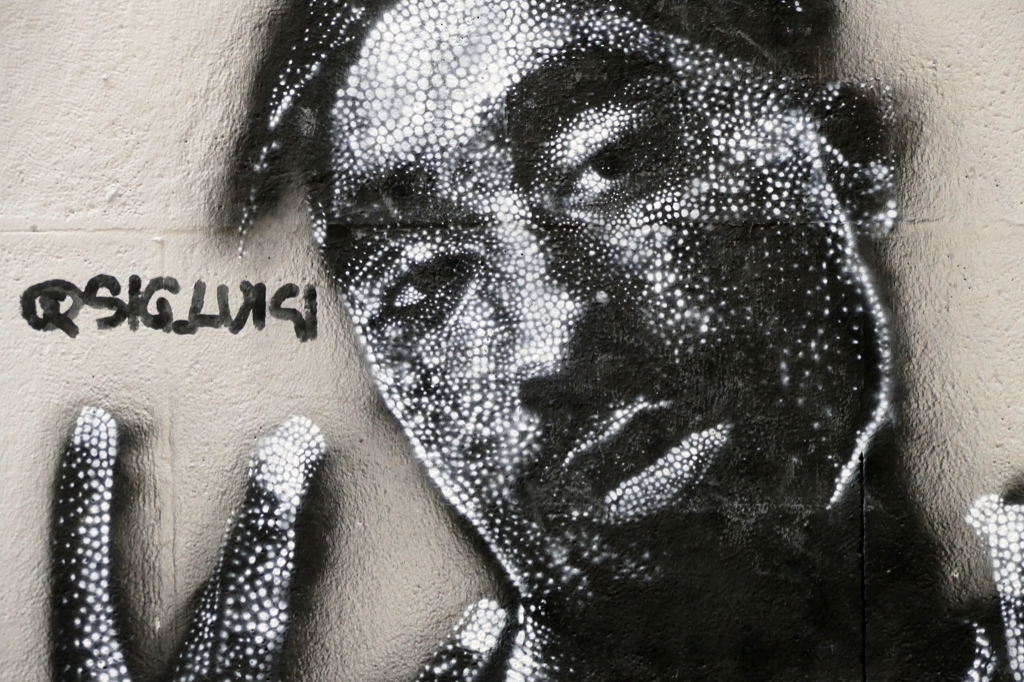
He defines himself as a stenciler, spray artist, and street warrior and has been spraying for 20 years. He enjoys altering his style and approach as he is constantly looking for something he hasn’t found yet.
Elías Taño
Elías Taño was born in 1983. He was working as a graphic designer at various studios and agencies in the Canary Islands, Barcelona, and Valencia.
In 2011 he returns to the art of drawing and illustrates covers of books and magazines. In addition, he designs posters for festivals, bands, plays – and unions, which comes as no surprise when you take a look at the topics of his comic-like murals.
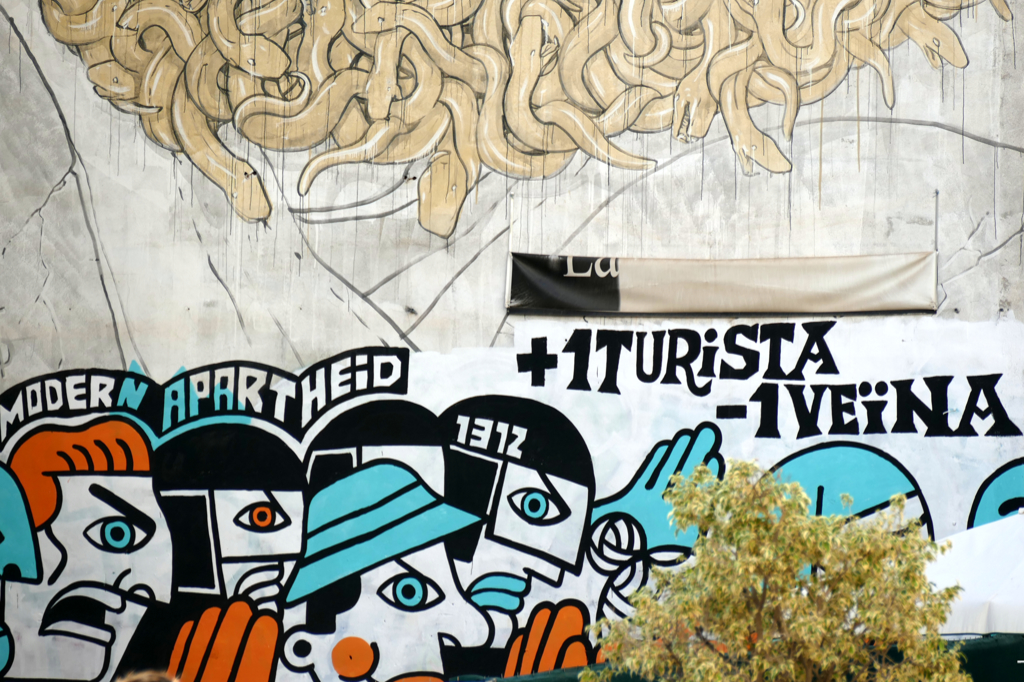
Hence, it’s only logical that he founded a political theater group with Carla Chillida in 2011.

Taño is a partner at the La Miliciana screen printing workshop. He teaches master classes in illustration and has published a book of his posters and drawings.
As if all this is not enough, he organizes art festivals and paints murals in Italy, Poland, Guatemala, Mexico, and Chile, to name just a few places.
Xemayo
Xema González Vidal aka Xemayo was born in Valencia in 1989.
At the age of 18, he moved to Almería where he got in touch with the local graffiti and urban art scene at the end of 2008.
In 2010 I began his studies at the Almería Art School. Commuting between Valencia and Almeria, he began to work as a tattoo artist in 2015.

In the same year, he began to organize different graffiti and urban art festivals in his native Valencia. Xamayo also participated in many urban art events, festivals, and conventions in Spain and many other European countries such as Denmark, England, Germany, Holland, Portugal, and Romania.
His signature motifs are hyper-realistic portraits.
Xolaka
Ángel Caballero Rioja was born in the town of L’Alcudia de Crespins in 1982. At the age of 18, he moved to Valencia to study Fine Arts at the San Carlos Faculty of the Polytechnic University. In 2007, he graduated.

Under the pseudonym Xolaka, he engages in visual arts, but also in multimedia and web design.
He has dedicated himself to urban art like murals relatively recently.
On Instagram
Unfortunately, I cannot introduce all the great artists that are embellishing Valencia’s façades. And even those few I’m presenting above have created many more amazing pieces.
So if you want to dig deeper into the subject – or get inspired for your upcoming trip to Valencia – check out these accounts of the above-featured artists:
Blu
Cabiscol Poietikos
David de Limón
Disneylexya
Escif
Azucena González
Julieta XLF
La Nena
Luis Lonjedo
Sig. Luigi
Elías Taño
Xemayo
Xolaka
How to Get Around
Walking
If you are visiting Valencia exclusively for street art, you can explore the old town walking. As you can see on the map below, the most impressive pieces are decorating walls’n’structures right in the heart of the El Carme district or at least in the vicinity.
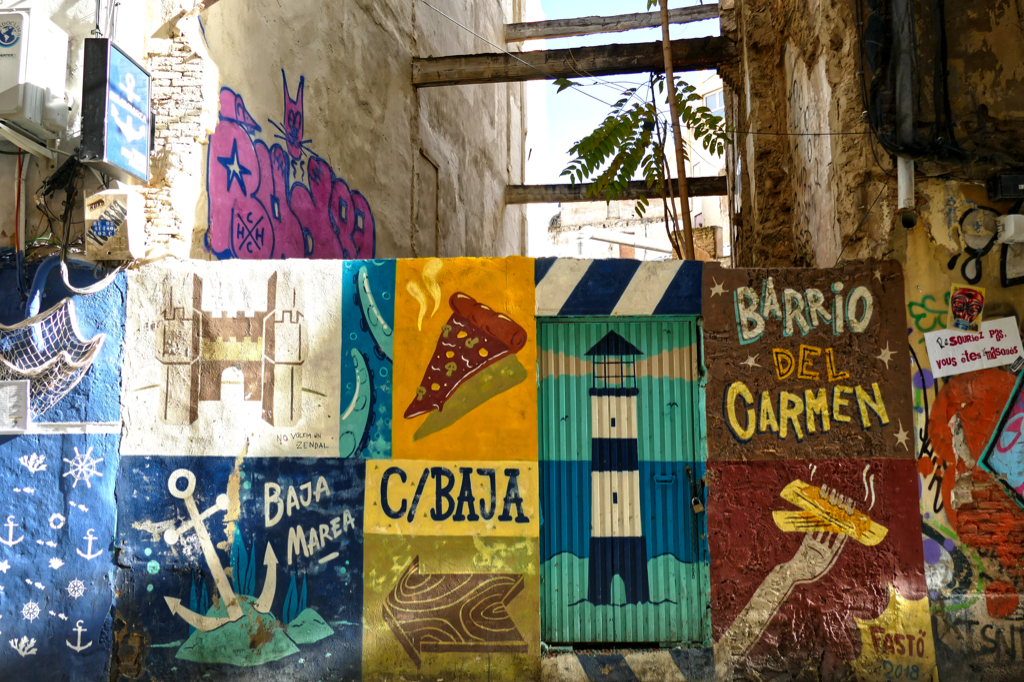
However, if street art is only one aspect of your visit, you should keep in mind that Valencia is Spain’s third-largest city – and it shows. Will say, I’m an avid walker, and yet, I opted for taking the bus quite often. There is so much to see and distances can be unexpectedly long.
Fortunately, like all larger cities in Spain, Valencia has a comprehensive and well-functioning bus system and also a metro system. The latter, however, is more interesting for going into the suburbs than for moving around within the city center limits.

A single bus ride costs 1,50 €uros. You can save a lot of money by getting a Bonobús travel card. You need to pay 2 €uros for a rechargeable card and then 8,50 €uros for ten rides.
If you get a Valencia Tourist Card*, unlimited use of public transportation – also from and to the airport – is included. In this case, you should obtain your card already at the airport. If you pre-book it online, you’ll save an additional 10 percent.
A single trip on the metro costs between 1,45 and 3,60 €uros.
Cycling
While driving in the city center is rather a drag than a convenience, Valencia can easily be explored by cycling. If your hotel doesn’t have bikes for rent, you can get them for instance at DOYOUBIKE for 10 €uros per day. However, DOYOUBIKE also offers guided city tours by bike, so make sure to check out their website.
Another great option is Valenbisi, one of these city bike companies that you find practically everywhere in Europe. You can rent their bikes at around 275 stations throughout the city. First, you have to subscribe to a weekly card for 13.30 €uros on their website. With your subscription, you get an unlimited number of rides. The first half-hour of every ride is free. For every additional half-hour, you’ll be charged 0.50 €uros.
My Tip: As you return your bike to a station, you can book another one right away. This way, your free half-hour will start from zero.
Map
This map should help you to find the murals I’m introducing in this post.
Searching for Street Art was only one of many amazing activities on my visit to Valencia. To read about the rest, go to this comprehensive guide! Also, in my general Guide to Spain, you’ll find further valuable information that will make your own trip much smoother and more enjoyable.
Pinnable Pictures
If you choose to pin this post for later, please use one of these pictures:
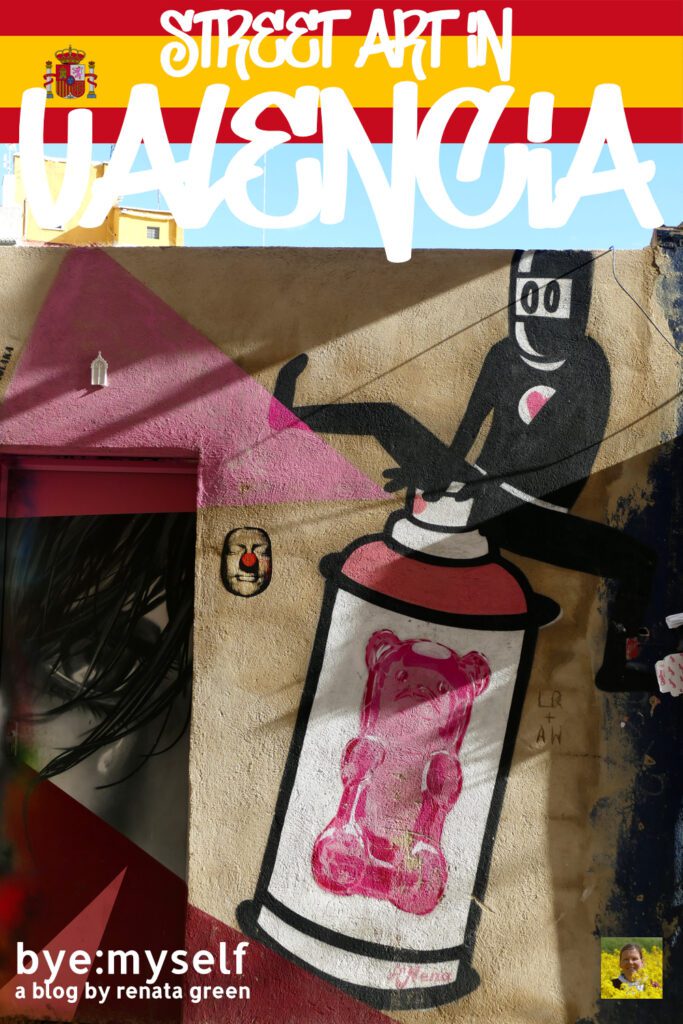
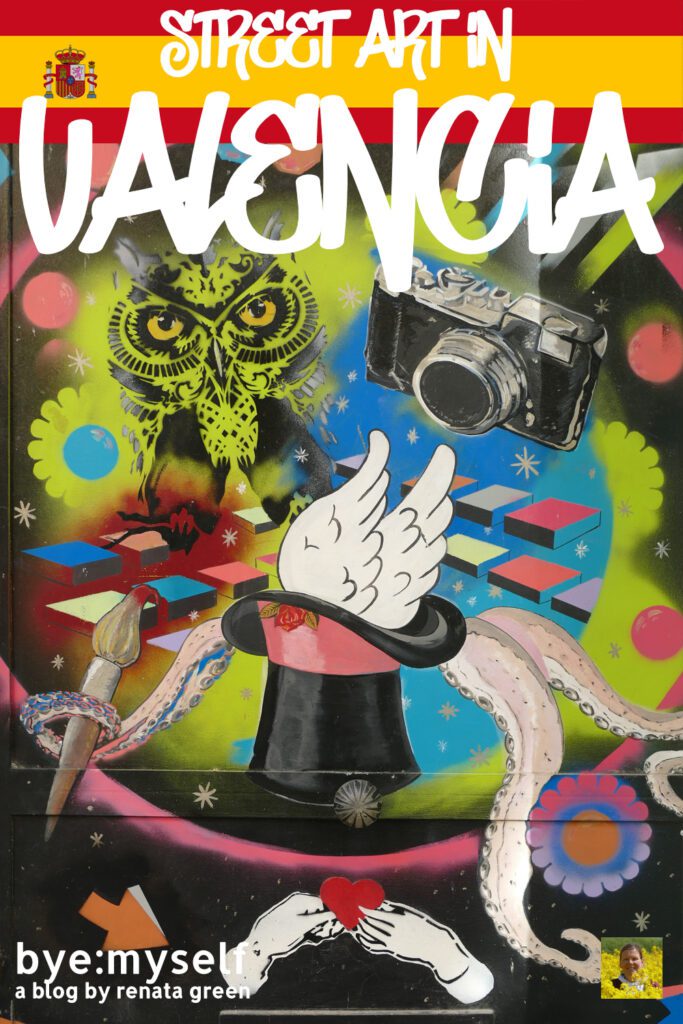
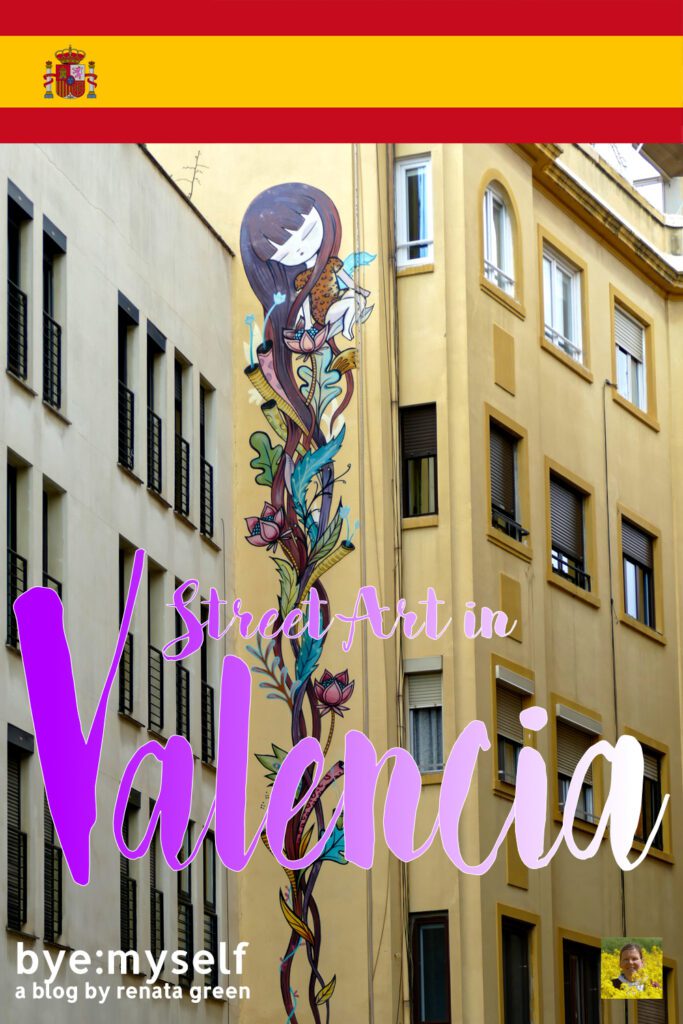

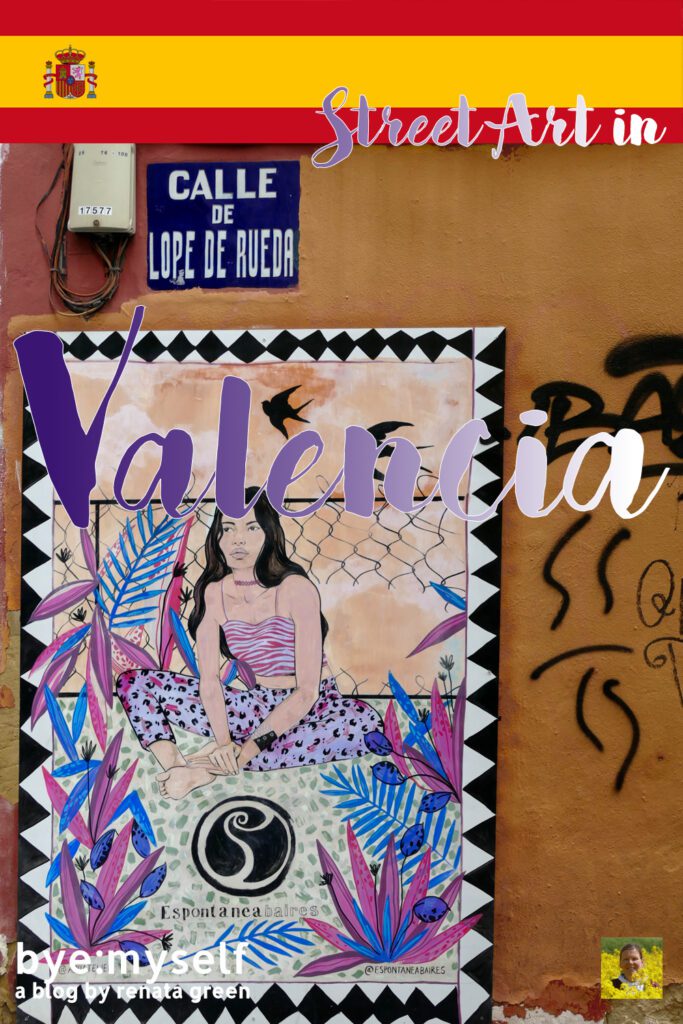
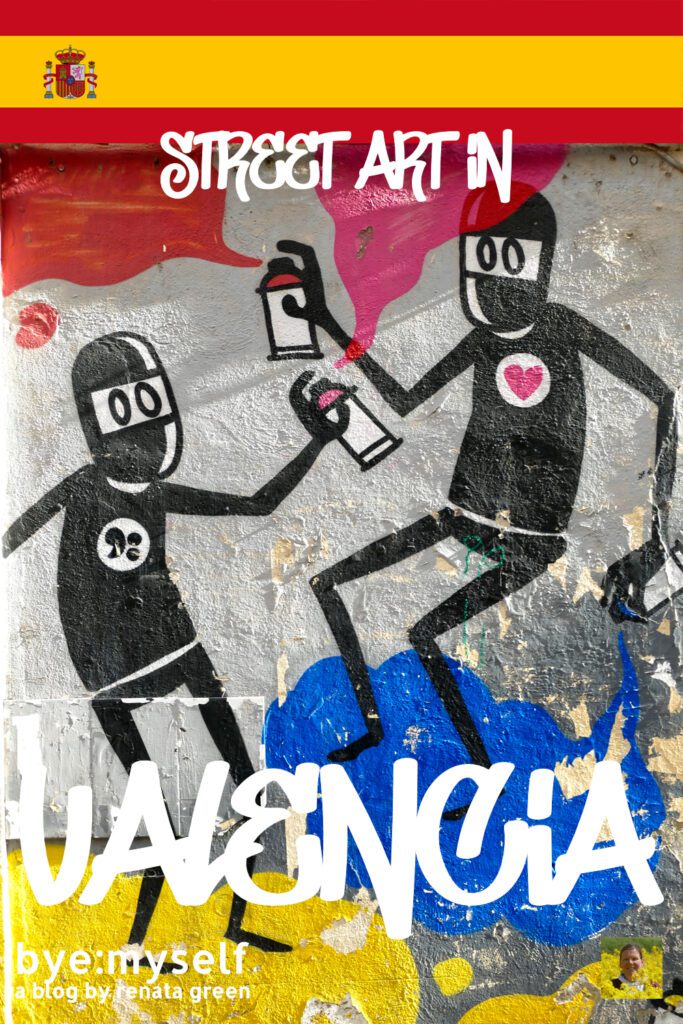
Did You Enjoy This Post? Then You Might Like Also These: